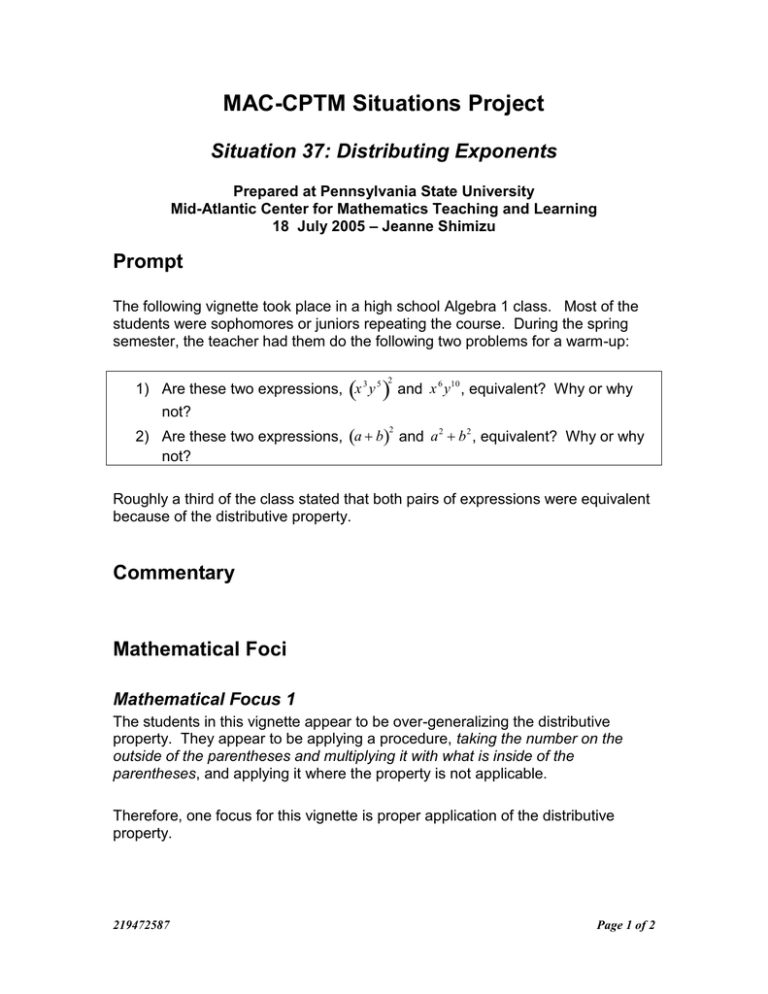MAC-CPTM Situations Project Situation 37: Distributing Exponents
advertisement

MAC-CPTM Situations Project Situation 37: Distributing Exponents Prepared at Pennsylvania State University Mid-Atlantic Center for Mathematics Teaching and Learning 18 July 2005 – Jeanne Shimizu Prompt The following vignette took place in a high school Algebra 1 class. Most of the students were sophomores or juniors repeating the course. During the spring semester, the teacher had them do the following two problems for a warm-up: 1) Are these two expressions, x 3 y 5 and x 6 y10 , equivalent? Why or why 2 not? 2) Are these two expressions, a b and a 2 b 2 , equivalent? Why or why not? 2 Roughly a third of the class both pairs of expressions were equivalent stated that because of the distributive property. Commentary Mathematical Foci Mathematical Focus 1 The students in this vignette appear to be over-generalizing the distributive property. They appear to be applying a procedure, taking the number on the outside of the parentheses and multiplying it with what is inside of the parentheses, and applying it where the property is not applicable. Therefore, one focus for this vignette is proper application of the distributive property. 219472587 Page 1 of 2 Mathematical Focus 2 The students in this vignette do not have a deep understanding of what an exponent is. It may be the case here that the students have an understanding that m 3 means m m m-- but only when the base is a constant or a single variable. When the base is more complicated and parentheses are included in the expression, as 2 2 illustrated by x 3 y 5 and a b , they may be enticed by the parentheses and the appearance of a number outside of the parentheses to apply what they recalled of a learned procedure. Take the number on the outside of the parentheses and multiplying it with what is inside of the parentheses. Therefore, a second possible focus for this vignette is the meaning of exponents k and expressions equivalent to A where A is more complex than a simple constant and a single variable raised to a power. For problem 1, x 3 y 5 means “ x 3 y 5 times x 3 y 5 .” Therefore, we apply the law 2 of exponents for products ( m a m b m a b ) to show x 3 y 5 and x 6 y10 are 2 equivalent expressions. 2 x 3 y 5 x 3 y 5 x 3 y 5 x 3 x 3 y 5 y 5 x 6 y10 . For problem 2, a b means “ a b times a b.” Since we have the product of two binomials, a different law is needed to carry out the multiplication. 2 a b a ba b aa b ba b a 2 ab ba b 2 a 2 2ab b 2 2 Although students may have thought they were applying the distributive property 2 to show that a b and a 2 b 2 were equivalent, it is because of the distributive property of multiplication with respect to addition that a b and a 2 b 2 are not equivalent. 2 References END OF SITUATION DISCUSSION – END OF SITUATION DISCUSSION 219472587 Page 2 of 2





